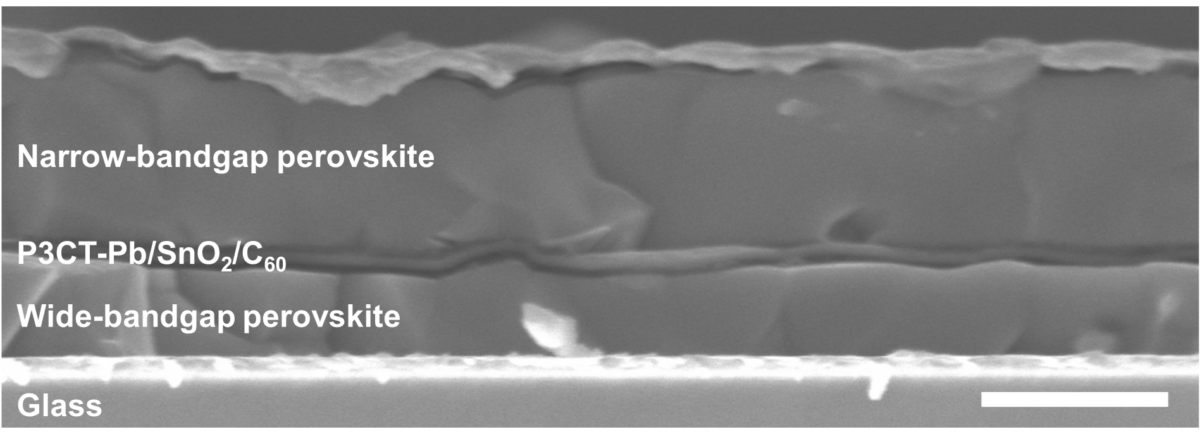A group of researchers led by the University of Toledo in the United States have fabricated an all-perovskite tandem solar cell with a wide-band-gap top cell based on tin-lead (Pb-Sn) perovskite and a low-band-gap bottom cell relying on a conventional perovskite substrate.
“The technology readiness level (TRL) of the tandem device investigated in this study is still low at TRLs 2-3,” the research's corresponding author, Zhaoning Song, told pv magazine. “Our work, however, proves the feasibility of enhancing the stability of all-perovskite tandem solar cells, but more work needs to be done to apply this technique to industrial production.”
The key feature of the tandem cell is the top device's hole transport layer (HTL), which was fabricated with a Pb-doped compound known as poly[3-(4-carbox- ybutyl)thiophene-2,5-diyl] (P3CT), a material that reportedly offers excellent stability and relatively high hole mobility.
“We introduce Pb doping to increase its work function and minimize the energy level offset with the Sn-Pb perovskite,” the academics explained, noting that P3CT represents a valid alternative to commonly used PEDOT-PSS. “The Pb dopants also provide nucleation sites to enable high-quality Sn-Pb perovskite film growth.”
The group built the top cell with a substrate made of indium tin oxide (ITO), the novel HTL, the Sn-Pb perovskite absorber, an electron transport layer (ETL) based on buckminsterfullerene (C60), a bathocuproine (BCP) buffer layer, and a silver (Ag) metal contact.
The champion cell built with this architecture achieved a power conversion efficiency of 22.7%, an open-circuit voltage of 0.884 V, a short-circuit current density of 32.0 mA cm2, and a fill factor of 80.3%. It was then combined in a tandem device with an 18.7%-efficient bottom cell based on a perovskite absorber with a bandgap of 1.7 eV, an HTL made of a phosphonic acid called methyl-substituted carbazole (Me-4PACz) and an ETL relying on C60.
The champion P3CT-based tandem achieved an efficiency of 27.8, an open-circuit voltage of 2.147 (2.146) V, a short-circuit current density of 15.7 mA/cm2, and a fill factor of 82.6%.
“The P3CT-based tandems also show a higher average efficiency of 27.0% than PEDOT: PSS-based devices, proving excellent reproducibility of the high-efficiency tandems with the P3CT-Pb HTL,” the group emphasized. “Doping P3CT with Pb cations reduced the valence band offset with Sn-Pb perovskite and provided nucleation seeds for enhancing perovskite crystallization, resulting in improved film quality.”
The P3CT-based tandem was also found to retain around 97% of its initial efficiency after 1,000 h.
According to Song, the cost of the doping technique is almost negligible, as the lead iodide material used for doping is the same source material used for producing the perovskite absorber layer, and only a trivial amount is needed for doping. “Yet, it is worth noting that the polymer hole-transport material used in this study is still expensive due to its complexity of synthesis and limited production scale,” he further explained.
The new cell technology was introduced in the study “Suppressed deprotonation enables a durable buried interface in tin-lead perovskite for all-perovskite tandem solar cells,” published in Joule. “Our molecular design strategy for stabilizing the perovskite/HTL interface provides a direction for achieving efficient and stable all-perovskite tandem solar cells,” the team concluded.
This content is protected by copyright and may not be reused. If you want to cooperate with us and would like to reuse some of our content, please contact: editors@pv-magazine.com.




By submitting this form you agree to pv magazine using your data for the purposes of publishing your comment.
Your personal data will only be disclosed or otherwise transmitted to third parties for the purposes of spam filtering or if this is necessary for technical maintenance of the website. Any other transfer to third parties will not take place unless this is justified on the basis of applicable data protection regulations or if pv magazine is legally obliged to do so.
You may revoke this consent at any time with effect for the future, in which case your personal data will be deleted immediately. Otherwise, your data will be deleted if pv magazine has processed your request or the purpose of data storage is fulfilled.
Further information on data privacy can be found in our Data Protection Policy.